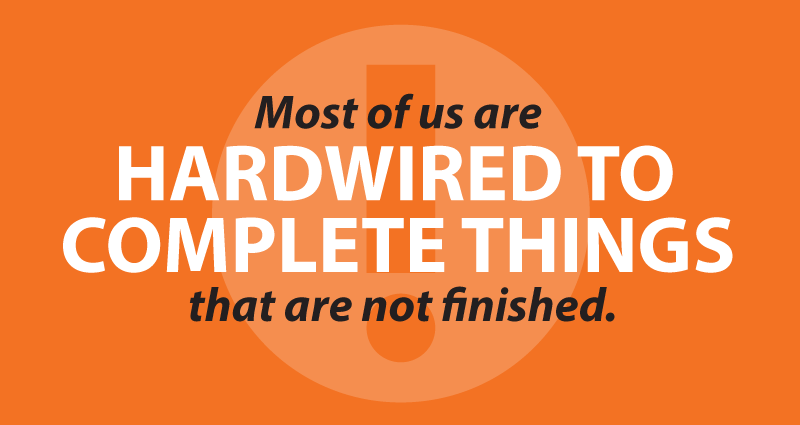
Want someone to remember your marketing? Open a gap
If you really want someone to remember your marketing, open a gap.
Don’t believe me? Try singing “Happy Birthday” without singing the last few words. Go ahead. Try it. Hum it to yourself if you are too embarrassed to sing out loud.
Did you find it tough not to sing (or hum) those last few words anyway?
Most of us are hardwired to complete things that are not finished.
In psychology, this is called the Zeigarnik effect. It’s named after Bluma Zeigarnik, a psychologist who studied and tested the effect after someone noticed that waiters seemed to remember incomplete orders better than those that were complete and paid for.
Participants in her study were asked to complete a series of tasks from solving puzzles to assembling a box. Half of the participants were subtly interrupted by the supervisor, while others were left uninterrupted. Afterwards, each were asked to recall the details of their tasks, and those that were interrupted had 90% better recall.
Incompleteness needs a resolution.
From Zeigarnik’s results it has been suggested that this desire for a resolution can cause a person to focus on something until it has been completed. While this effect can certainly be used to your advantage in marketing (more on that later), all you have to do is look around to see how common it is in our everyday lives:
- TV – Daytime soaps and prime-time dramas like 24, Twin Peaks and X-Files used cliffhangers and intrigue to ensure their audience tuned in to the next episode. Reality show competitions winnow down the number of players so that viewers feel the suspense. Some are less obvious, as CNN used to end their news with a sports trivia question to keep viewers tuned in for their sports show coming up next.
- Novels – Every chapter in Dan Brown’s DaVinci Code seemed to end with a “Zeigarnik hook” and J.K. Rowling laced her Harry Potter books with so many extra plot lines and situations that readers were certainly hooked. Charles Dickens even used the technique, as many of his works were originally serialized before being published as complete novels.
- Online Role Playing games – Moving from one scenario to the next, building credits and earning bonuses, buying weapons and slaying foes, finding treasures to go to the next level…and real life is put on hold until the quest is finished.
- To Do Lists – Okay, not as entertaining as TV or novels, but our To Do Lists organize and reward us as we check off each task, as we work to complete everything we need to do.
So what does all this have to do with marketing?
Marketing is about getting and keeping your audience’s attention, moving them to a successful conclusion. This technique is simply another tool in your box, with several approaches to use:
- Fill in the blank – We are just finishing a product campaign for a credit union that uses an ellipsis (…) in every headline. By starting a thought for the reader, then letting them fill in the gap…we engaged their imagination and began to get them emotionally invested in their own happy ending.
- Solve the puzzle – Use a story-telling approach by first hooking their attention, then sprinkling small clues throughout the copy in order to keep your reader in search of a conclusion.
- Tune In Next Week – Consider rolling out your new product in a series of episodes instead of all at once. Just be sure that you let them know when to expect the next installment and finish up with a resolution.
- Collect ’em All – If you have multiple items that make up a desirable set, roll them out over time and let people collect them all. Think McDonald’s Happy Meals, and market it so that getting the whole set becomes more valuable.
- To Do List – This approach works well if you have a series of steps that need to be taken to get to the prize. Be sure to acknowledge their completion of milestones, to add to their sense of accomplishment.
Pick the most suitable approach, and then look at your media options. Could you add a cliffhanger into your email subject line? Can you turn your web banner into a scenario where someone has to click to find out what happened? What if you serialized teasers for your next Facebook campaign?
What would entice you to fill in the gap?
(BTW, if you hadn’t noticed, I used a very simple example of the Zeigarnik effect earlier in this post. Do you remember reading “While this effect can certainly be used to your advantage in marketing (more on that later)…”? Hopefully that planted a seed in your brain that compelled you to read all the way down to to the end.)
- Why your CU really needs an intranet - February 19, 2025
- Are you scared yet? - October 22, 2024
- OMG! Who really IS our competition?!? - September 24, 2024
